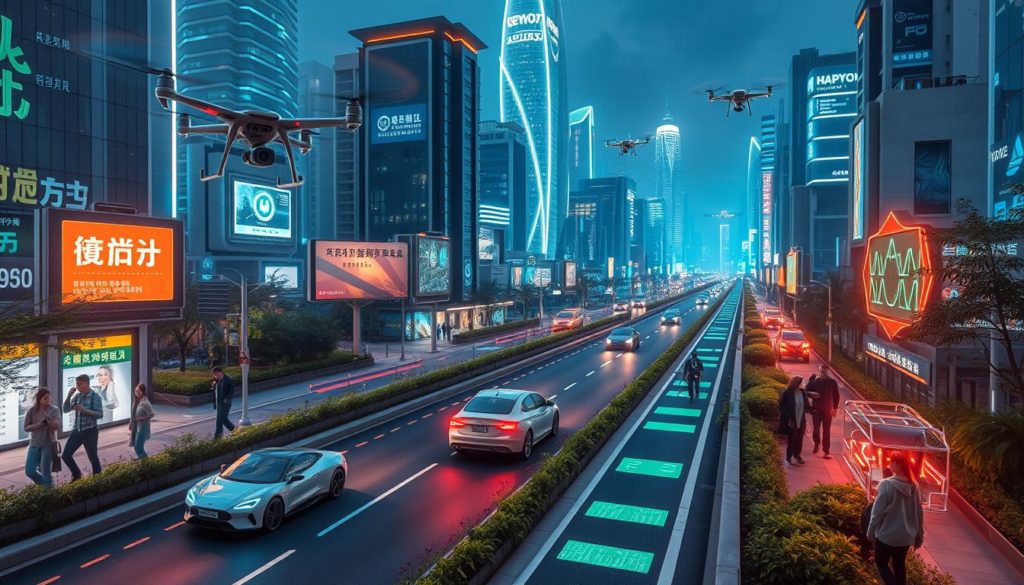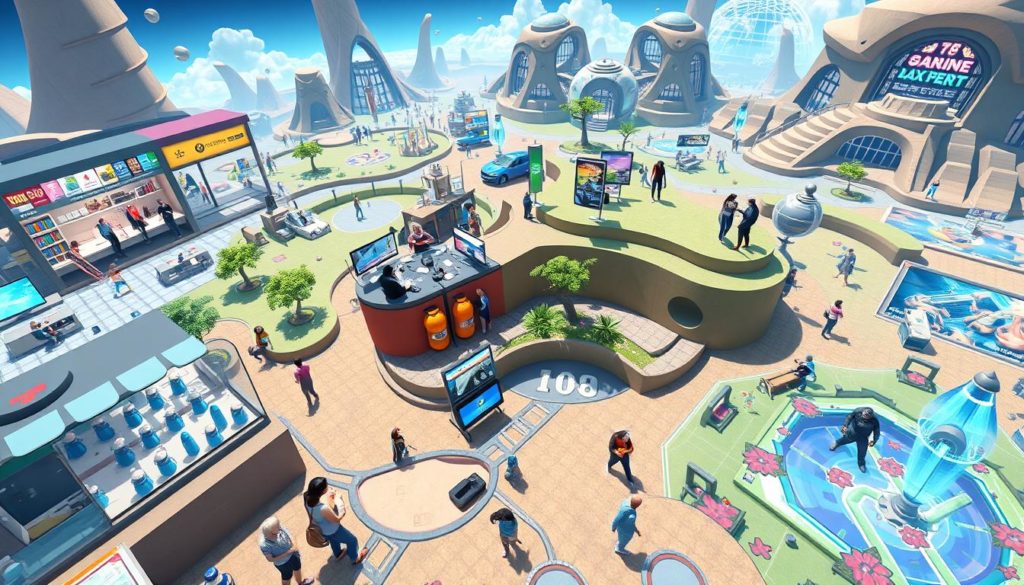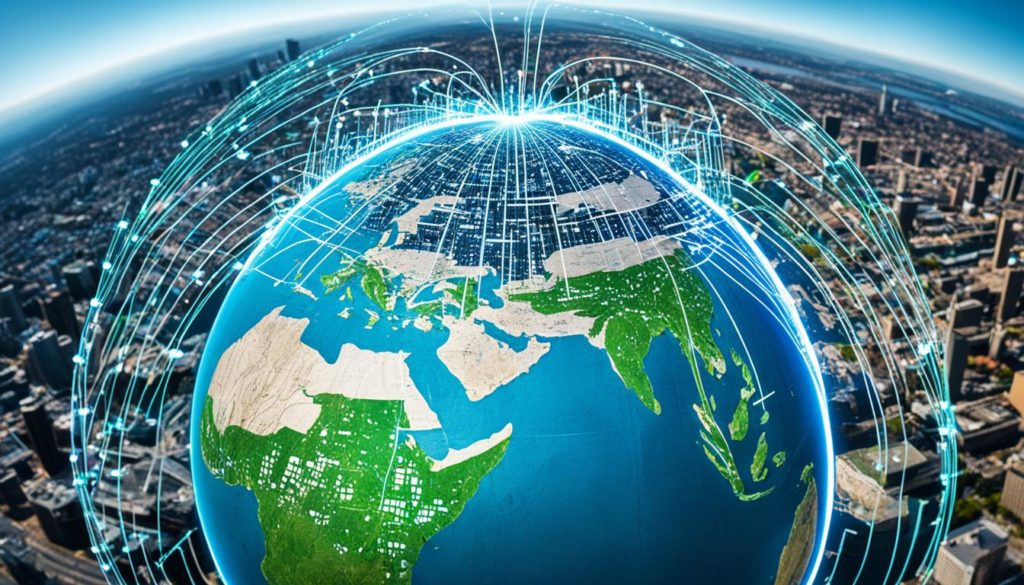
In 2023, Google searches for Generative AI (Gen AI) skyrocketed by nearly 700 percent. This shows how fast technology is changing our world. It’s moving from making the internet more real in places like the Metaverse to using AI and cloud services everywhere.
This rapid growth is leading to big changes in how we use technology. It’s making our digital world more advanced and innovative.
Looking at the top tech trends of 2024, we see a story of change and growth. Companies are updating old systems with new tech, linking the old to the new. Blockchain is helping rebuild trust in businesses and governments.
AI is becoming key in many areas, bringing new ways to work and connect. These changes are set to transform how we live and interact with each other.
Key Takeaways
- Generative AI saw a nearly 700 percent spike in Google searches in 2023, underscoring its growing significance.
- Adoption of AI and multicloud environments is driving efficiency and trust in digital transformation efforts.
- Mainframe modernization is playing a crucial role in linking legacy systems with future technologies.
- Blockchain technology is predicted to bring over $176 billion in commercial value by 2025, highlighting its importance in establishing institutional trust.
- The Metaverse is forecasted to add $5 trillion to the global economy by 2030, emphasizing the impact of immersive digital experiences.
Understanding Web 3.0: The Next Evolution
Web 3.0 started in the 1990s. It’s a big change from just getting information to a system that puts users first. This third-generation internet is all about being open, decentralized, and better for users. It’s a new time for how we use the internet.
Key Features of Web 3.0
Web 3.0 has some key features:
- Decentralization: It spreads power among many users, not just a few. This makes things safer and more open, making it hard to censor and keeping privacy strong.
- Blockchain Technology: It’s used for safe deals and smart contracts. Blockchain keeps data safe and makes sure everything is clear and trustworthy.
- Semantic Web: It lets machines understand content. This makes data connections smarter.
- AI Integration: Artificial intelligence makes online experiences better and more personal for users.
- Decentralized Platforms: Apps work without a single boss. This includes things like NFTs, social networks, and systems like IPFS and Filecoin for sharing content.
Impact on User Privacy and Control
Web 3.0 changes how we think about privacy and control. With decentralized platforms, users get to decide more about their data. This makes online experiences safer and more personal. It also helps with things like money and finance, making the digital world fairer.
This new internet era is a big change. It lets users work well together on different devices. It’s all about smart, safe, and focused online interactions. The Web 3.0 era promises to change how we use the internet for the better.
Emerging Role of AI: From Generative AI to Industrial Applications
In 2022, generative artificial intelligence (AI) became well-known. It quickly became a big part of business in 2023. This AI type is great for growing the economy and making technology better for companies. We’ve learned a lot about how AI can help the economy and how companies trust it.
Generative AI’s Economic Potential
Generative AI is changing the game. It can make apps faster and help people who aren’t tech experts. This could really help the economy grow. A Deloitte report says it could add up to $4.4 trillion a year to the global economy.
Tools like OpenAI’s GPT-4V and Google’s Gemini show how AI is growing. They work on tasks like understanding language and seeing images.
A survey by IBM found that companies want AI for many reasons. They want it to make things easier, cheaper, and more automated. Generative AI is making a big difference in retail, healthcare, and finance. It’s making things better, more personal, and helping things grow.
Trust and Adoption of AI in Enterprises
For AI to really take off in companies, people need to trust it. Companies need to show that AI is reliable. Research shows that AI can make some jobs better, especially for those who are new or have less experience.
In short, using generative AI in business can lead to big economic gains. It can free up time for people to do more creative and complex work. But, companies need to work on building trust in these new technologies.
| Key Aspects | Generative AI |
|---|---|
| Economic Potential | Up to $4.4 trillion value addition annually |
| Adoption Drivers | Accessibility, Cost Reduction, Automation |
| Applications | Healthcare, Financial Services, Retail |
Green Technology: Paving the Way for a Sustainable Future
Green technology is making a big leap towards a sustainable future. It’s changing many areas like energy, transport, and farming. This change will bring big wins for our planet and our wallets. Let’s dive into two key areas leading this green shift.
Advancements in Green Hydrogen
Green hydrogen is becoming a big deal in green tech. It’s made differently than regular hydrogen, using clean energy like sun or wind. This makes it almost emission-free. It’s a game-changer for industries and transport, helping us use less fossil fuels.
Green hydrogen tech is getting better and better. This means it’s becoming more efficient and ready for use everywhere.
Decentralized Energy Systems
Traditional power grids are being replaced by decentralized ones. These new systems let smaller units work on their own. They make energy networks stronger and more flexible.
By using solar and wind power, these systems cut down carbon emissions a lot. They also make energy safer and more accessible. This lets communities control their own energy needs better.
Green tech keeps getting better, helping fight climate change and save resources. It’s all about using clean energy and new tech to make our future greener and more sustainable.
Metaverse: The Future of Digital Interaction
The Metaverse combines virtual and augmented reality, setting a new standard for digital interaction. It’s changing how companies train, work together, and explore new business ideas. Experts predict its value could reach $5 trillion by 2030, showing its huge potential.
Use Cases in Enterprises
The Metaverse is being used in many ways in businesses. It’s making workspaces more interactive and efficient. Here are some key examples:
- Training and Development: Metaverse training is faster and more engaging than old methods. It helps employees learn better and remember more.
- Employee Collaboration: VR lets people explore virtual spaces as if they were there. This makes teamwork more interactive and fun.
- Business Insights: Digital twins in the Metaverse give businesses real-time data. This helps them make better choices and offer personalized services.
- Cost Efficiency: Using the Metaverse for learning is cheaper. It cuts down on costs from traditional training methods.
- Enhanced Interactivity: Digital twins of people make interactions in the Metaverse more real. This makes it more engaging.
VR content in the Metaverse makes learners more confident. AR adds digital info to the real world, making experiences richer.
AI and Machine Learning are key in making the Metaverse smart and dynamic. They help create engaging NPCs, personalized experiences, and efficient virtual economies. As XR blends the physical and digital, we’ll see more of it in our lives and work.
Technologies like blockchain and NFTs will make the Metaverse safer and more trustworthy. AR and VR headsets will get lighter, cheaper, and clearer. This will make immersive experiences available to more people.
- Faster and more efficient training methods.
- Enhanced emotional engagement with VR content.
- Real-time business insights from digital twins.
- Cost-effective learning solutions at scale.
- Enhanced interactive and immersive experience with AR and VR.
| Key Aspect | Impact |
|---|---|
| Training Speed | 4x faster |
| Emotional Engagement | Higher with VR |
| Learning Confidence | Increased |
| Focused Training | Higher concentration |
| Cost Effectiveness | Better when scaled |
Digital Twin Technology: Revolutionizing Testing and Development
Digital twin technology is changing how we develop and test products. It started with Dr. Michael Grieves’ idea in 2002 at the University of Michigan. Now, it’s used in many fields like healthcare, aerospace, automotive, and urban planning.
This technology creates virtual models of real products and processes. It lets businesses try out different designs without risk. This makes the product development process faster and more efficient.
In Formula 1, digital twins help make quick design changes. This boosts innovation and saves time. In manufacturing, they watch over production lines, predict when equipment might fail, and plan maintenance.
Digital twin technology is also used in healthcare and aerospace. In healthcare, it creates personalized models for treatment planning. This improves care and lowers risks. Aerospace companies use it to check on parts, predict when they need maintenance, and keep things safe.
Urban planners use it to test environments, manage utilities, and plan infrastructure. This technology helps them make better decisions.
3D printing works well with digital twin technology. It makes it easier to go from digital to physical products. This can cut development time and costs by up to 50%.
Digital twin technology also helps make better decisions with real-time data. It makes teams work together better. This leads to better products and happier customers.
But, using a lot of data and making sure everything works together is hard. Still, the future looks bright. Advances in IoT, AI, and machine learning will make things even better.
- In healthcare, digital twins can predict problems and improve care.
- Automotive manufacturers use them for design, testing, and maintenance.
- Urban planners use them to improve traffic and infrastructure.
- Supply chain managers use them to better logistics and save money.
The market for digital twin technology is growing fast. It’s expected to go from $3.5 billion in 2020 to $73.5 billion by 2027. As we move towards a more digital world, digital twin technology will play a big role.
Top Tech Trends in 2023: Key Takeaways
In 2023, cutting-edge technology is changing the game. Web 3.0 is leading the way, aiming to give power back to users. This shift brings openness and democracy to the digital world, opening up new economic opportunities.
The Metaverse is growing fast, with a predicted value of up to $5 trillion by 2030. It’s changing how we live and work. AR/VR tech is also getting a boost. Plus, humanoid robots are becoming more common, taking on roles like concierges and factory workers.
Green tech is also making big strides, with improvements in green hydrogen and energy systems. Quantum computing and IoT are transforming industries. For example, U-Scan is a new urine scanner for health checks. Microsoft’s $10 billion investment in OpenAI shows AI’s huge potential in industry.
Cloud services are becoming more popular in companies. Gartner predicts a 20% rise in low-code development this year. Customer Data Platforms are expected to grow by 24.5% CAGR by 2027. SaaS, PaaS, and IaaS will soon manage 50% of corporate operations, changing the digital world.
FAQ
What are the top tech trends of 2023?
The top tech trends for 2023 include the Metaverse, AI, and multicloud environments. They also include core modernization of businesses and advancements in green technology. These trends are changing how businesses work and how we interact with each other.
What is Web 3.0 and what are its key features?
Web 3.0 is the next generation of the internet. It’s built on decentralization and blockchain technology. It offers a semantic web, better data connectivity, and more control over personal data for users.
How does Web 3.0 impact user privacy and data control?
Web 3.0 boosts user privacy and data control. It gives people more power over their information. This shift makes the internet safer and more personal for everyone.
What is the economic potential of generative AI?
Generative AI could add .4 trillion to the economy. It speeds up app development, helps non-tech users, and boosts economic growth in many areas.
Why is trust important for the adoption of AI in enterprises?
Trust is key for AI adoption in businesses. Workers and users need to trust AI tools. This trust lets businesses use AI to improve efficiency and innovation.
What advancements have been made in green hydrogen technology?
Green hydrogen technology has made big strides. It’s a sustainable fuel with almost no emissions. This shows its big role in a greener future.
How do decentralized energy systems contribute to sustainability?
Decentralized energy systems help the environment. They let smaller units produce and store energy on their own. This cuts carbon emissions and supports a green energy future.
What are the enterprise use cases for the Metaverse?
The Metaverse is used in businesses for training, teamwork, and new business models. By 2030, it could be worth up to trillion. It’s changing how we work online.
What is digital twin technology and how is it used?
Digital twin technology creates virtual copies of real things. It helps industries test and improve products safely. For example, Formula 1 uses it to make quick design changes.
What are the key takeaways from the top tech trends in 2023?
The top tech trends in 2023 show a mix of new technologies with big economic and industry changes. From Web 3.0 to generative AI and green tech, 2023 is set for big tech leaps.
Future App Studios is an award-winning software development & outsourcing company. Our team of experts is ready to craft the solution your company needs.










